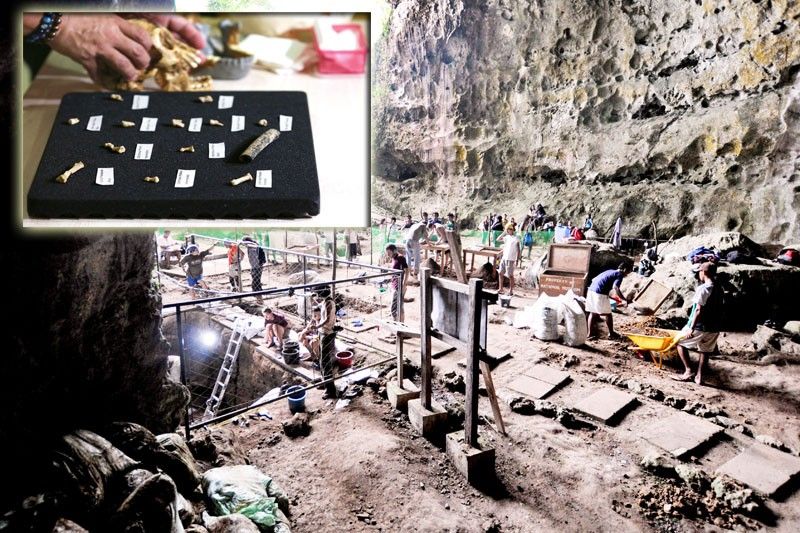Fossils of new human species discovered in Philippines cave

MANILA, Philippines — Fossilized remains of individuals discovered in Callao Cave in Cagayan have been confirmed to belong to a previously undescribed species of prehistoric humans that may have roamed Luzon some 50,000 years ago.
The new species, named Homo luzonensis, was described in a paper published in scientific journal Nature on Wednesday.
It was discovered by a team of local and international scientists led by archaeologist and University of the Philippines professor Armand Salvador Mijares, who analyzed fossilized remains recovered during excavations in Callao Cave in 2007, 2011 and 2015.
Homo luzonensis was described using ancient teeth, hand and foot bones that belonged to at least three individuals that lived during the Late Pleistocene period, or around 50,000 to 67,000 years ago.
It included the foot bone of the so-called Callao Man, discovered by Mijares in 2007, which he earlier described as belonging to a small-bodied member of modern humans or Homo sapiens.
At a press briefing on Wednesday, Mijares said he long suspected that the bone belonged to an entirely new species, but he was not able to provide proof until after the discovery of other specimens.
In their paper, the researchers, who also included Florent Détroit of the French National Museum of Natural History, said the new species has unusually primitive characteristics that resemble both the early hominid species (Australopithecus) and those close to modern humans.
And while the available fossils prevent researchers from coming up with a full reconstruction, Mijares said the bones that they recovered suggest that the species is smaller than modern humans.
He said the fossilized remains also suggest that Homo luzonensis stood erect and could have been capable of climbing, although their locomotor and manipulative abilities have yet to be described.
Mijares said the discovery underscores the significance of the Philippines in human evolutionary research.
“The discovery adds a new member to the genus Homo and makes Southeast Asia an important evolutionary region,” he said. “It also raised more questions to answer such as its lineage, how and when it reached Luzon island.”
National Museum director Jeremy Barns described the discovery as a major event in the history of science in the Philippines.
“This is a gamechanger that everyone must take note of – that the Philippines is put on the map,” he said. “Our sites are deserving of higher importance and that’s a testament to the efforts of our archaeologists throughout the decades, to really promote awareness and acknowledge the importance of Philippine sites.”
In addition to the UP Archaeological Studies Program, the National Museum of the Philippines and the French National Museum of Natural History, also involved in the research were the Université de Poiters, Université Toulouse and Université de Bordeaux in France; and the Griffith University and Australian National University in Australia.
Oldest human remains
Researchers said the specimens were recovered three meters below the current cave floor.
They are believed to be part of the remains of prehistoric humans that were washed into the cave before being fossilized.
Dating of the fossils determined them to be 50,000 to 67,000 years old, making them the earliest human remains to be discovered in the Philippines so far.
They predate the remains of the so-called Tabon Man discovered in Palawan, which belong to the species of modern humans who lived around 30,000 to 40,000 years ago.
According to the researchers, analysis of the bone and tooth samples of Homo luzonensis revealed a combination of characteristics that belong to both old and new hominid species.
“The mosaic of structural traits clearly distinguishes it from other species of the genus Homo, especially from the contemporary species known in Southeast Asia such as Homo sapiens and Homo floresiensis,” said the researchers, respectively referring to species of modern humans and another species discovered in Indonesia in 2004.
“For instance, the upper molars of Homo luzonensis more closely resemble those of Homo sapiens than other Late Pleistocene homonin species, but the molars of the new species are still much smaller. Because of their extremely small size and simplified crown morphology, they also vary remarkably from those of Asian Homo erectus and Denisovan hominins,” they added.
Mijares said the Homo luzonensis appears to be a “dead-end” species, meaning there is no indication that they evolved further as to have descendants who are still alive today.
More questions
He said more research is needed to answer questions raised by the new discovery, including where they came from, when they arrived, the extent of their presence and how they died out.
Mijares did not rule out the possibility that Homo luzonensis settled in Luzon hundreds of thousands of years before the estimated date of the fossils.
Last year, a separate research described stone tools and butchered animal fossils, discovered in nearby Kalinga, that established the presence of prehistoric humans in the Philippines by as early as 709,000 years ago.
Mijares said the Homo luzonensis could be the same toolmakers described in the research, although they have yet to discover actual tools used by the new species.
The archaeologist likewise underscored the need to establish when modern humans arrived in Luzon, noting there are still a lot of “blank spaces” in understanding the evolutionary history in the Philippines.
Mijares said the Homo luzonensis fossils will later be turned over to the National Museum and is expected to be exhibited in the Museum of Natural History.
- Latest
- Trending
































